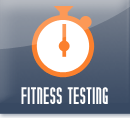There are two types of strength testing. Maximal strength testing, often called 1RM, measures the maximum amount of weight you can lift one time. Sub-maximal repetition testing uses a lighter weight, more repetition and then a formula to estimate maximum strength.
The results of strength testing can be expressed in absolute terms or divided by body weight to estimate relative strength. For rugby the bench press is used to test upper body strength and the leg press or squat to test lower body strength.
Make sure at all times that you do the tests with strict form and control and that you always have a spotter to assist you. Due to the high intensity nature of the testing injury risk is increased significantly if strict technique and form is not followed.
Upper Body & Lower Body Strength – Bench Press & Leg Press or Squat
Maximal 1RM Tests
Procedure
1RM testing can be a time-consuming process. If done correctly it can take 20 to 40 minutes for a true max test.
Start with a warm-up and a light weight you can easily handle for 5-10 reps. Rest two minutes. Increase the weight by 10-20 percent and do a second warm-up set of 3-5 reps. Rest two minutes again. Increase the weight again by another 10-20 percent and and do a final warm-up set of 2-3 reps.
This time rest three to four minutes. Increase the load by 5-10 percent, and try one repetition. Rest three to four minutes. If your last attempt was successful, increase the weight by 5 pecent and try another one repetition. If it was not successful
decrease the weight by 2.5 to 5 percent and try again.
Repeat this process until only repetition can be performed with proper technique. Always rest three to four minutes between attempts. Ideally, your 1RM should be determined within 5 sets of finishing the warm-up. Taking longer could result in fatigue affecting the accuracy of the test. Normally this type of testing is accurate to within 5 percent of the true 1RM.
Sub-maximal Tests
This type of strength testing is to be used as an alternative to 1RM testing and is more suitable for younger players or players without a good strength base of with little strength training experience.
Procedure
These tests use formulas to predict maximum strength. In most cases these tests are as accurate as the 1RM tests. Start with a warm-up with a light weight you can handle for 5-10 reps. Rest two minutes. Increase the weight by 10 to 20 percent and do as many reps as possible. You should reach failure between 2 and 10 reps.
Use the following formulas to predict your 1RM:
Upper body max rep predictor
Weight used for reps x (1 / (1 – [reps made x 0.025]) )
Lower body max rep predictor
Weight used for reps x (1 / (1 – [reps made x 0.035]) )
3RM or 5RM Tests
3RM or 5RM strength tests are commonly done in rugby especially for the lower body squat test to reduce injury risk and for younger or less experienced lifters. As with the other tests warm-up thoroughly and then determine your 3RM or 5RM by
trial and error establishing your score within 5 lifts. After each attempt, increase or decrease the load by 2.5 to 5 kilograms depending on the outcome of the attempt. Remember to take three to four minutes rest between
attempts.
• Core Stabilizing muscles – Side Ramp
The need for strong core stabilizing muscles for rugby makes testing this component of a player’s strength important. Establishing whether a player has a weakness in this area is critical for the design of future training programmes.
Procedure
1. Lie on either side in a full side bride position with your legs straight. Extend your top foot in front of your lower foot for support. Lift your hip off the floor so that your feet and elbow support your body, creating a straight line from head to toe. Place your free hand on your supporting shoulder.
2. Use a stopwatch to record how long you can maintain this side ramp position. Hold until failure, that is until you lower your hip or your back is no longer straight.
3. Take a 5 minute recovery time and test the other side, comparing the two.

